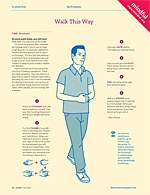It’s week three of the mindfulness-based stress reduction courses I’m currently teaching, and our main work is mindful movement. It’s an interesting week for me as course leader, partly because I don’t connect comfortably with some of the movements we practice. Historically, I tend to enjoy moving the body quickly or not at all. So, I love playing football, partly because the pace of the game gives my body a sense of energy and release, and I love lying and resting in the sunshine, which often brings a feeling of letting go and relaxation. Slow movements, like those in Hatha Yoga or gentle walking, on the other hand? My answer used to be: “No, thank you.”
The more I practiced meditation, however, the more I began to explore this resistance to “Mindful Movement.” What did I actually feel when I allowed myself to move slowly? When I took my mind into my body at these times, I discovered restlessness, impatience, irritation, and boredom. I wanted either to stop or to go faster. Hmm, interesting. Wasn’t this a pattern that I had also identified with my mental experience—that I habitually approached life at breakneck speed, and then flopped or fell into an exhausted torpor? Weren’t these the same uncomfortable emotions that cropped up when I took time and care over a piece of writing, or listened attentively to what someone else was saying in a conversation, or tried to build some flat-pack furniture, piece-by-piece? Hmm, even more interesting.
What Mindful Movement Teaches Us:
The more I engaged with mindful movement practices, the more I felt it was showing me my habitual style of engagement. Instead of avoiding the unpleasant feelings that arose when I slowed down, I was now paying attention to them, seeing how they affected me, and choosing to stay with them. I still wasn’t enjoying it, but I was noticing how this shift in relating style was expanding out into my life. Instead of giving things up when I felt bored or impatient, I developed a greater willingness to experience and accept those feelings, which often led to starting and completing tasks (from cooking a meal to writing a book) that might previously have gone undone. I started to feel more grounded, and a lessening of the tendency to flutter from one idea, job, house, spiritual path, or relationship to another. I felt more centred, more willing, more at ease, even during emotional turbulence.
The more I engaged with mindful movement practices, the more I felt it was showing me my habitual style of engagement.
I’m not saying that these changes were all the result of mindful movement. But it seems that only by engaging with a practice I found challenging could I see more clearly how I reacted to other challenges in life. I find sitting meditation and body scan practices relatively easy, probably because the physical stillness they require are, to some extent, part of my existing pattern (“exhausted from rushing around—okay, now I’ll go and sit or lie down to meditate”). But because they are more easily co-opted to that pattern, there’s more chance of my remaining unconscious as I practice them. Whereas slow mindful movement means doing something really different—taking attention to the sensations of a state between frantic activity and stopping, and leaning into the discomfort of that. It feels very alive, very annoying, and very worthwhile.








